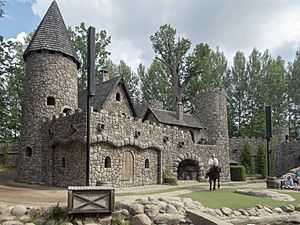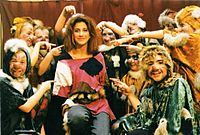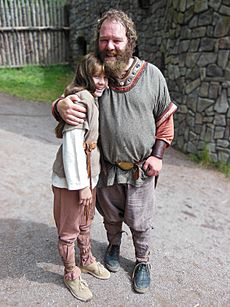Ronia, the Robber's Daughter facts for kids

First edition
|
|
| Author | Astrid Lindgren |
|---|---|
| Original title | Ronja rövardotter |
| Illustrator | Ilon Wikland |
| Country | Sweden |
| Language | Swedish |
| Publisher | Rabén & Sjögren |
|
Publication date
|
1981 |
| Pages | 235 pp |
| ISBN | 91-29-54877-2 |
| OCLC | 9462379 |
| LC Class | MLCS 82/9917 |
Ronia, the Robber's Daughter (in Swedish, Ronja rövardotter) is a popular children's fantasy book. It was written by the famous Swedish author Astrid Lindgren and first came out in 1981.
This exciting story has been turned into many things, like a prize-winning movie from 1984, musicals in Denmark and Germany, and even a Japanese anime TV show. The book has been translated into at least 39 different languages around the world.
Story Summary

Ronia is a young girl who grows up with a group of robbers. They live in a big castle deep in the woods of Scandinavia during the early Middle Ages. Ronia is the only child of Matt, who is the chief of the robber clan. Everyone expects her to become the leader of the group one day.
On the very day Ronia was born, a huge lightning bolt struck Matt's Fort. It split the castle into two separate parts. Ronia spends her childhood only with Matt's robber clan. But then, another group of robbers, led by a man named Borka, moves into the other half of the castle. This makes the old rivalry between the two groups even worse.
One day, Ronia sees Birk Borkason near the big crack in the castle. Birk is Borka's only son. Ronia has never met another child before, so she feels a bit sad that he is from the rival Borka clan. Birk challenges her to a game of jumping across the chasm. The game stops when Birk almost falls, and Ronia quickly saves him. After this, they slowly become good friends.
The next winter is very long and cold. Matt's robbers have plenty of food, but Borka's group on the other side of the chasm is struggling. Ronia secretly brings food to Birk through a hidden passage. They become very close friends, but they both know they cannot tell their families about their friendship.
Later that year, Ronia's father, Matt, captures Birk. To get Birk back, Ronia offers herself to the Borka clan. This means she must be exchanged for Birk. Because of this, her father Matt gets very angry and says he no longer sees her as his daughter.
Birk and Ronia decide to run away together into the woods. They live in a cave and have many exciting and sometimes scary adventures. They meet different creatures that live in the forest, like trolls, forest gnomes, and harpies. In the end, both families realize their fighting was wrong. Everyone is reunited, but Ronia and Birk decide that they do not want to live the life of a robber.
Adaptations
The story of Ronia has been brought to life in many different ways, from movies to musicals.
Film
In 1984, the book was made into a Swedish fantasy film. The movie was directed by Tage Danielsson. Astrid Lindgren herself wrote the screenplay, which is the script for the movie.
The film was a huge success. It became the highest-earning movie in Sweden in 1984. It also won a Silver Bear award at the Berlin International Film Festival in 1985. More than 1.5 million people watched the movie in Sweden.
Musical
In 1991, the book was turned into a Danish musical called Ronja Røverdatter. The music for this show was written by the Danish composer Sebastian.
Later, in 1994, a German musical called Ronja Räubertochter was created. This musical was written by Axel Bergstedt in the German language. It features an orchestra, a band, and more than one hundred people performing on the stage.
Stage Plays
The story has also been performed as stage plays in different places.
- A production was held in the Balver Höhle in 1993 and again in 2004.
- Another German adaptation was performed in Oberkirch (Baden) in 2006.
- In Sweden, a production directed by Ronny Danielsson was performed at Stadsteatern Stockholm in 2014, 2016, and 2018.
Anime TV Series
A CGI television series from Japan, titled Sanzoku no Musume Ronia, started on October 11, 2014. This show was made by several companies, including Dwango, NHK, NHK Enterprises, Polygon Pictures, and Studio Ghibli. The series was directed by Goro Miyazaki.
Translations
Ronia, the Robber's Daughter has been translated into 39 languages. It's interesting to note that the two English versions of the book translate some of the Swedish names differently.
| Swedish, 1981 Rabén & Sjögren Ronja Rövardotter |
English, 1983 Methuen The Robber's Daughter |
English, 1985 Puffin Ronia, the Robber's Daughter |
|---|---|---|
| Ronja | Kirsty | Ronia |
| Mattis | Matt | Matt |
| Lovis | Lena | Lovis |
| Borka | Ranulf | Borka |
| Undis | Hanna | Undis |
| Birk | Burl | Birk |
| Skalle-Per | Skinny-Pete | Noddle-Pete |
| Tjegge | Shaggy | Shaggy |
| Pelje | Proudfoot | Pelle |
| Fjosok | Fulke | Foolok |
| Jutis | Jolly | Jutto |
| Joen | Jip | Jep |
| Knotas | Knott | Knott |
| Turre | Tapper | Tapper |
| Tjorm | Tobbit | Torm |
| Sturkas | Bumper | Bumper |
| Lill-Klippen | Snip | Little Snip |
See also
 In Spanish: Ronja, la hija del bandolero para niños
In Spanish: Ronja, la hija del bandolero para niños



